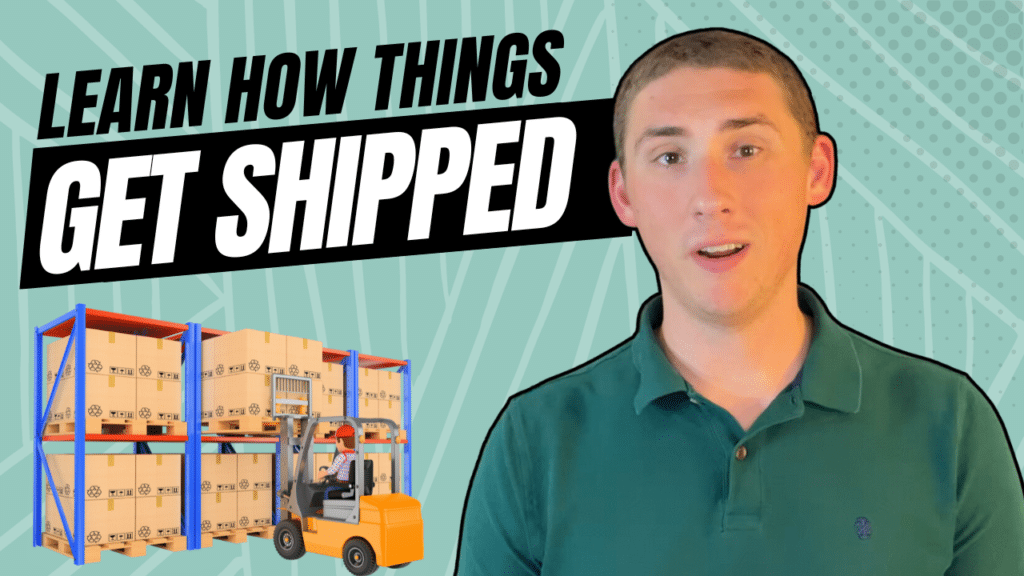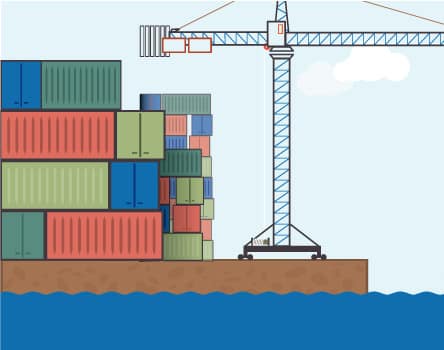Ever wonder what happens after you buy stuff online?
How does it actually get to you?
You’re not the only one who’s curious. We get asked this all the time. How exactly does order fulfillment work?
How does a click on a website turn into a package on your doorstep?
In this video, we’re going to explain how order fulfillment works. This video is for a general audience, but if you find yourself needing help with order fulfillment, we’d be happy to help. We’re Fulfillrite, an order fulfillment company that has shipped for thousands of eCommerce and crowdfunding clients. We’d be happy to help you ship too. The quote doesn’t cost a thing, so if nothing else, you get some good information about pricing. Link in the description.
But enough self-promotion. Let’s talk about how order fulfillment works.
Let’s start with…
The 11 Steps of Order Fulfillment
We run two warehouses – one in New Jersey, not too far from the shore, and another in Salt Lake City, Utah. In both our warehouses, day in, day out, we follow the same steps to fulfill orders. Our competitors do the same, as does every small business owner shipping out orders on their own.
Here’s how it works, speaking from our perspective.
1. Sellers notify us about incoming shipments.
For items to leave the warehouse, they have to be in the warehouse in the first place! So sellers will send their inventory in big shipments. That inventory is held onto until it’s time to go out. This is even true for the sellers working out of their homes.
When those shipments are due to come in, sellers let us know with an advance notice that includes details about the shipment. This helps us prepare our team to receive and handle the items efficiently.
2. Bulk shipments arrive and we bring the inventory inside.
When shipments arrive at our warehouse, we unload the goods. These are usually packed in boxes, often on pallets for easier handling. Depending on the shipment’s size, we might use conveyors or pallet jacks to move the goods inside quickly and store them in a specific area.
3. We update our records after receiving.
After receiving the items, we update our inventory records. This includes confirming the quantity and storing location of each item. This ensures we know where everything is for future retrieval and order fulfillment.
4. The items are stored.
We store the received items in the designated areas of our warehouse. This is done manually or with the help of machinery like pallet jacks, depending on the item’s size and weight.
5. When an order comes in, we process the order data.
When you – as the customer – place an order, the seller’s system sends us your order details and shipping information. This includes the specific items you ordered and their quantities. We then use this information to locate and prepare the items in our warehouse.
6. We pick items from the shelves.
We find the specific items you ordered in our warehouse, using our inventory system for guidance. A warehouse worker collects these items and brings them to the packing area, updating our inventory count in the process.
7. We pack items for shipping.
At the packing station, we choose the appropriate packaging for each item. This depends on the item’s nature – fragile items need more protection, while others might just need a simple bag. Our goal is to use the smallest possible packaging while ensuring the items are safe during shipping.
8. We print and apply postage.
We calculate the shipping cost based on the package’s size and weight, and then print the corresponding postage. We use different carriers like UPS, USPS, FedEx, or others depending on the destination. After printing, we attach the postage to the package and prepare it for carrier pickup.
9. Mail carriers pick up packages for delivery.
Mail carriers regularly visit our warehouse to collect packages. We sort the packages by carrier to streamline this process. Once picked up, the carriers then start their process of delivering the packages.
10. Carriers deliver mail to your home.
Packages go through a series of hubs and sorting facilities operated by the carriers. They are transferred from one location to another until they reach the hub nearest to you. From there, your local postal service handles the final delivery to your doorstep.
For most items, that’s the end of the road! But for the 20-30% of eCommerce orders that get returned, there’s an eleventh step.
11. When customers return items, we process them.
When customers return items, we receive them for a second time. From there, the returned items are either restocked or disposed of, depending on their condition and the seller’s policy.
And that’s it! That’s the whole process – but that leaves a major question unanswered:
Who Ships Orders?
So who actually ships eCommerce orders when it’s time to send them out? Who goes through all these steps?
That depends on the business model, but there are basically three ways you can do it. There is self-fulfillment, through a third-party logistics company, or 3PL, and dropshipping. We’ll get into detail on these three models now, starting with…
Self-Fulfillment
When businesses choose self-fulfillment, that means they manage every aspect of the fulfillment process internally. This means they store their inventory, package products, and handle shipping logistics themselves.
The biggest benefit of this method is the control it offers over the entire process. Businesses can personalize packaging, personally ensure quality control, and directly manage inventory, even if that means waking up at 3 in the morning to hand count stock.
Self-fulfillment is a good fit for small-scale operations or businesses with unique products that require special handling and a lot of customization. For example, think of all the Etsy stores out there that sell handmade items.
It’s not all sunshine, though. Self-fulfillment can be demanding in terms of time and resources. You need space to store your inventory. And, of course, it means being responsible for all the shipping logistics, which can become complex with an increasing volume of orders. It’s labor-intensive and time-consuming, and can become exhausting.
That’s why a lot of sellers work with…
Third-Party Logistics (3PL) Companies
Put simply, working with a 3PL means having another company handle fulfillment operations. These providers handle inventory storage, order packing, and shipping, allowing businesses to focus on other aspects like product development and marketing.
The #1 advantage of using a 3PL provider is scalability. As the business grows, 3PLs can easily handle increased order volumes without the need for the business to invest in additional space or staff. They also often have established logistics networks, which can reduce shipping times and costs.
The downside is less control over the fulfillment process, which might affect the customer experience or simply make the seller feel uncomfortable. Selecting the right partner makes all the difference here. Reliability and speed matter a lot here.
This model is ideal for businesses experiencing rapid growth or those looking to expand their reach without significant investment in logistics infrastructure.
On the other hand, you could just get the manufacturer or supplier to ship for you, as in…
Dropshipping
So in dropshipping, a business sells products that are shipped directly from the supplier to the customer. The seller does not keep products in stock but instead transfers customer orders and shipment details to either the manufacturer or a wholesaler, who then ships the goods directly to the customer.
The neat thing about dropshipping is that sellers don’t have to handle inventory. That means it’s possible now to start up a product-based business with virtually no capital.
Of course, dropshipping is hard even though many people make it out to be easy. It’s hard to keep on top of product quality. It’s hard to keep costs down. It’s hard to stand out among other dropshippers doing the same thing and using the same suppliers.
When it comes to dropshipping, it’s a good fit for sellers who are talented marketers with a lot of time and patience and who are proactive about picking reliable manufacturers and suppliers.
No matter which model you choose, though, certain basic problems are likely to come up again and again. So here are some…
Common Problems & How They Get Fixed
It’s not hard to run out of stock. Items get lost in the mail and sometimes they break. Then there are returns, which can happen for any number of good reasons…or no reason at all.
You might be wondering, as a shopper, how businesses manage to ward off these problems given how complex order fulfillment can be.
So let’s start by talking about…
Inventory Management Issues
To avoid the frustration of out-of-stock items or delayed restocking, sellers use advanced inventory management systems. These systems keep track of stock levels in real-time, using techniques like Just-In-Time (JIT) to ensure they have just enough products available. This means when you order an item, it’s more likely to be in stock and ready for shipment.
But just because the items are there doesn’t mean they’ll get to you on-time because of…
Shipping Delays
These can be a real pain. Sellers address this by working with multiple shipping carriers. This diversification means that even if one carrier faces issues, another can step in to deliver your order on time. Sellers also plan ahead for busy seasons to avoid delays. They keep you informed about your order’s status, so you’re never left in the dark about when your package will arrive.
Sellers also need to try to keep costs down for you, which means they have to avoid…
Excessive Returns
No one likes the hassle of returning a product. But it’s hard to know who hates it more: the seller or the buyer!
Either way, to minimize returns, smart sellers focus on providing accurate product descriptions and high-quality images on their websites. They also ensure that products are well-packaged to prevent damage during transit. If you do need to return an item, sellers have simplified the process and established clear policies, making it as hassle-free as possible for you.
Any seller that can manage their inventory well, keep return rates low, and mitigate shipping delays is well-positioned to succeed. After all, as shoppers, we don’t expect magic. We just expect to buy what we want when we want it and for packages to arrive when they say they will!
And there you have it! Whenever you – or one of your customers – clicks that buy button, a whole chain of events is triggered. Data is sent to the right people, who pull items from storage, pack them in boxes, apply postage, and send them where they need to go. Then the postal system does the rest.
Who does the shipping itself? Sometimes it’s the seller, sometimes it’s a 3PL they work with, and sometimes – it’s a manufacturer from a far away country.
But the basics always remain the same!
As a quick reminder, we’re Fulfillrite, an order fulfillment company that has shipped for thousands of eCommerce and crowdfunding clients. We’d be happy to help you ship too. The quote doesn’t cost a thing, so if nothing else, you get some good information about pricing. Link in the description.
If you enjoyed this video, please take a moment to like and subscribe. Don’t forget to slap some postage on that bell so we can express ship new videos to you as soon as they drop. And last but not least, if you have any questions, leave a comment below. We will personally answer as many as we can.
Thanks for watching!





